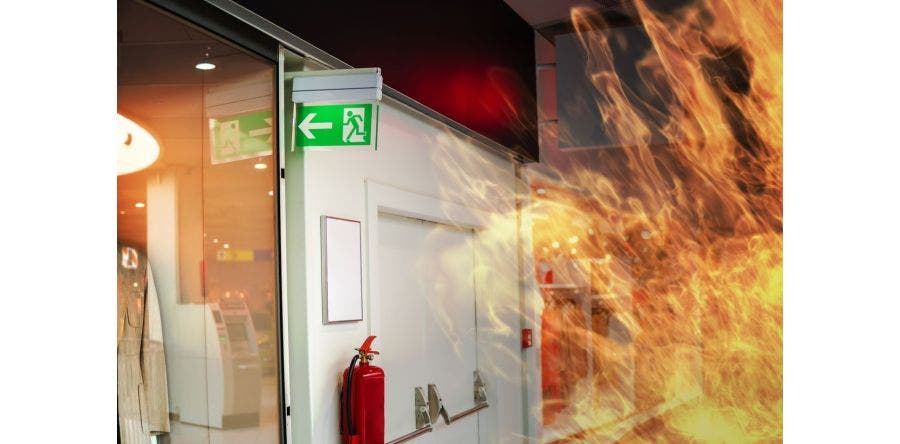Ship Exit Sign Safety Guidelines
Navigation aids can help provide boat occupants with similar information that street signs or buildings offer. Think of road barriers, stop signs, detours, and wayfinding. Vessels of all sizes require various levels of navigation aids to ensure occupants are able to be safe and find their way, especially during an emergency.
Depending on the size of the vessel, the emergency safety requirements vary. Working with the U.S. Coast Guard and other regulating authorities you can determine what (if any) type of marine exit signage is required for your vessel. National regulations and international conventions have made exit signs mandatory aboard a variety of merchant and passenger vessels. The purpose of the emergency exit signage on a ship is the same as those in buildings- to indicate the escape routes to follow during an emergency and also display other safety-related information.
What Type of Exit Sign Does My Ship Need?
There are a variety of exit sign technologies on the market today. The two most popular options internationally and within the United States are LED and photoluminescent. Depending on the location you need to place the exit sign you might only have a single option. Below are several differentiators between LED and photoluminescent exit signs.
Photoluminscent/Glow-in-the-Dark Exit Signs
Photoluminescent emergency exit signs have earned the name glow-in-the-dark because they do just that! With zero electricity, these are the most eco-friendly option on the market today. Think of all the glow-in-the-dark toys you see these days. Commonly these toys are using a substance called phosphor. Phosphor is a substance that exhibits luminescence, meaning it emits light when exposed to some type of radiant energy. In the case of photoluminescent exit signs, ambient light is absorbed into the exit signs, then stored, and later emitted when the power goes out.
You might be wondering how long an illumination photoluminescent exit signs hold- how can these things meet standards? UL 924 listed photoluminescent exit signs bring a minimum of 90 minutes of uninterrupted illumination. This means it meets both the requirements set forth by top regulating authorities, The National Fire Protection Agency (NFPA) and The Occupational Safety and Health Administration (OSHA). In fact, those exit signs that use long persistence phosphor (LPP) afford photoluminescent exit signs and markers to glow in the dark for well over 18 hours.
This substance and the technology behind them is unlike anything else on the market. It is safe, requires no battery back-up, no electricity, and even minimal maintenance. All of this adds up to major savings for vessel owners.
On average, the life span for photoluminescent exit signs is 25 years. They are fully recyclable and easy to replace. Vessel owners simply need to mount the signs according to regulations which means screwing them above doors and mounting them to ceilings, or walls. No electrician is required.
Thermoplastic/LED Exit Signs
This popular type of exit sign is excellent if your location lacks the ambient light photoluminescent exit signs require. While it is not as eco-friendly as its photoluminescent counterpart, the signs only require minimal power. These signs also use a battery backup in case of a power outage, so monthly maintenance checks are required to ensure the batteries are in full working order.
These exit signs usually last around 5 years and use roughly 5 watts of energy.
Ship Exit Sign Compliance
Like any emergency solution, exit signs on vessels are required to meet certain criteria. Start by connecting with your local fire marshal and the U.S. Coast Guard before installing any new exit and fire safety signage. Generally, as long as you meet all requirements set forth by regulating authorities you will be compliant, however, the requirements will vary by vessel certification.
Remember the Rules of the Road
While exit signs help people quickly evacuate during emergency situations, keep your occupants safe by following basic navigation rules- also known as “The Rules of the Road” that are laws governing the steering or sailing of a boat.
If all operators obeyed these laws, many accidents would be avoided. With collisions being the #1 type of accident for vessels, these Rules help ensure boats don’t collide with each other or other objects.
1. Post a lookout. Your vessel no matter the size should have at least one individual designated to watch for dangers.
2. Don’t speed. Be a good judge of your boat's speed, taking into account visibility (or lack of), vessel traffic, and maneuverability of the boat.
3. Avoid a collision. Take the proper actions to avoid a collision. This includes: overtaking, meeting head-on, and crossing the bow of another vessel.
Shop Ship Exit Signs
We believe that safety at sea requires the highest performing products, meaning they can last in the toughest conditions for extended periods of time.
Jessup Manufacturing is a global leader in photoluminescent emergency safety signage. Our line of exit signs and fire safety signs are UL 924 listed, meet NFPA 101, OSHA, ASTM standards E2072-00/E2073, and are made of "Safety Grade" materials.
Shop our entire selection online.



















